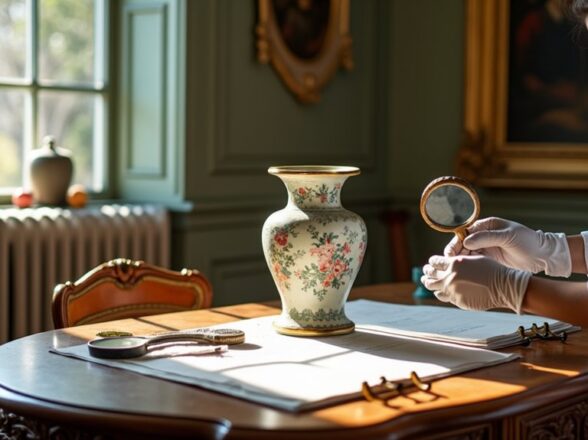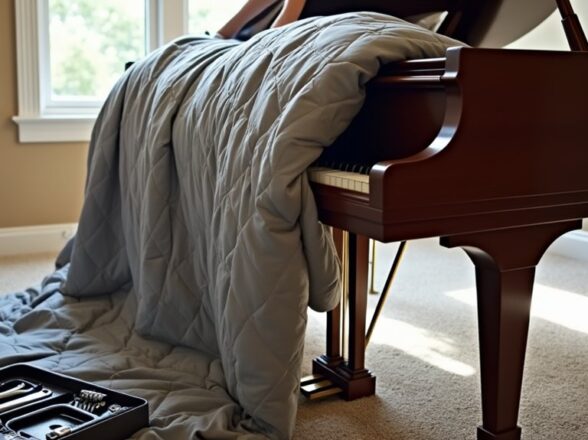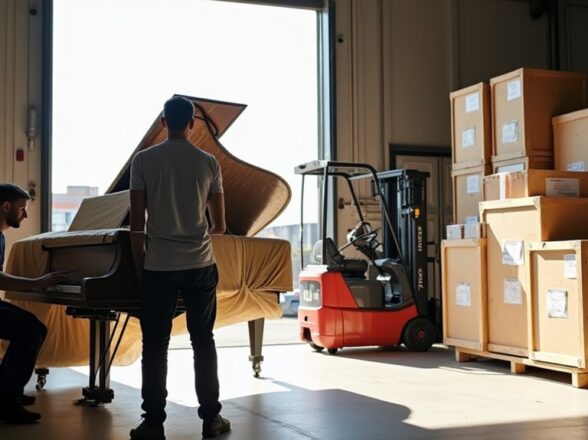How to Protect Paintings and Sculptures During a Move? Expert Techniques for Damage Prevention

To protect paintings and sculptures during a move, start by using professional art movers who understand how to handle delicate items. Gather high-quality packing materials like acid-free tissue, bubble wrap, and sturdy boxes, and assess the condition of each piece beforehand. Wrap each item securely and avoid moisture exposure, as it can damage artworks. During transport, use climate-controlled vehicles and secure the pieces upright. After arrival, inspect everything immediately and allow items to acclimate to their new environment. Understanding these steps helps guarantee the safety of your artworks throughout the moving process. There's even more you can explore regarding protection methods.
Importance of Specialized Care

When you’re moving valuable paintings and sculptures, understanding the importance of specialized care is vital. These artworks are delicate and vulnerable to damage from temperature changes and impacts during transit. Using professional art movers who specialize in handling these pieces guarantees they receive proper packing. They employ techniques like high-quality packing with acid-free materials and custom crates to protect the artworks. Additionally, documenting each piece with condition reports and photographs helps assess their state before and after the move. This documentation is essential for insurance purposes in case of damage. Engaging specialized relocation services assures tailored solutions that address the unique handling and transport needs of your valuable pieces, preserving their quality and integrity throughout the process. Many movers offer climate-controlled storage solutions to ensure sensitive items like fine art and antiques remain protected during transit and in temporary storage facilities. Furthermore, fine art moving services not only focus on the transportation of artworks but also provide specialized packing and unpacking assistance at the destination. These services often include setting up the pieces in their new environment, ensuring that they are displayed properly and securely. By leveraging the expertise of fine art moving services, you not only safeguard your investments but also enjoy peace of mind knowing that every aspect of the move is handled with precision and care. When planning a move involving valuable artworks, it is crucial to understand how to choose art movers that align with your specific needs. Look for companies with a strong reputation, experience in handling delicate items, and comprehensive insurance policies that cover any potential risks during transit. Additionally, seeking recommendations and reading customer reviews can provide insights into the quality of service and reliability of the movers, ensuring that your cherished pieces are in the best hands possible.
Identifying Potential Risks
When you're moving artwork, it's vital to recognize potential risks that can cause damage. Environmental factors like temperature and humidity can affect both paintings and sculptures, so climate control is key. Additionally, improper handling and packing materials can lead to serious issues, making it essential to address these vulnerabilities before you transport your art. Consider utilizing climate-controlled units to maintain optimal conditions and prevent damage to sensitive artwork during transit.
Environmental Factors Impacting Art
Artworks are vulnerable to a range of environmental factors that can jeopardize their integrity during a move. Temperature fluctuations can cause oil paintings to crack, while humidity can warp wooden sculptures. To mitigate these risks, using climate-controlled vehicles is essential. Moisture exposure can lead to mold or mildew, so it's important to use acid-free packing materials to maintain a dry environment. Here's a summary of key environmental risks:
| Environmental Factor | Risk to Artwork |
|---|---|
| Temperature Fluctuations | Cracking in oil paintings |
| High Humidity | Warping in wooden sculptures |
| Moisture | Mold and mildew development |
| Improper Packing | Damage during transit |
| Minor Vibrations | Cracks in frames or sculptures |
Proper handling is vital to prevent damage during transit. Ensuring that your fragile items are stored properly, perhaps using climate-controlled storage, can significantly reduce the risk of damage during transitions.
Handling and Transportation Risks
Protecting your artwork doesn't stop with managing environmental factors; handling and transportation risks also play a significant role in guaranteeing your pieces arrive safely. Art movers often face challenges like extreme temperatures and humidity, which can cause significant damage to delicate pieces. To prevent damage, it's vital to use proper packing materials that cushion your artwork and secure it during transport. Custom crating can also help protect fragile sculptures from minor vibrations that may occur while moving. Utilizing climate-controlled vehicles guarantees safe transport, keeping your artwork at a stable temperature. By hiring experienced art movers and selecting the right packing solutions, you can effectively mitigate risks associated with handling and transportation.
Material Vulnerability Considerations
While moving your artwork, it's vital to recognize the specific vulnerabilities of different materials. Each type of artwork can face unique risks during packing and transport.
- Oil paintings require climate-controlled environments to prevent cracking from temperature changes.
- Wooden sculptures can warp if exposed to high humidity, so controlling moisture is important.
- Glass surfaces on framed artworks need extra care; using painter's tape can help secure them and minimize damage.
Always use acid-free materials for packing to avoid chemical reactions that cause deterioration. To protect your artwork effectively, guarantee secure packing and cushioning. Understanding these material vulnerabilities will help you prevent damage and keep your pieces safe during the move.
Essential Preparation Steps

Before moving your artwork, you need to assess its condition carefully. Document any existing damage with photographs to create a reference for later. Next, gather high-quality packing materials and create an inventory list that details each piece's dimensions and special handling needs.
Assess Artwork Condition
To guarantee a smooth moving process, you must start by thoroughly evaluating the condition of each artwork. Begin by inspecting for any pre-existing damage. Document the condition with detailed notes and photographs. Measure the dimensions and weight of every piece to determine the appropriate packing needs. Identify the materials used to understand their sensitivity to environmental factors.
Consider these key aspects:
- Assess the fragility of each piece and note any vulnerabilities.
- Compile an inventory that includes the value and any specific handling requirements.
- Use your notes to protect and transport the artwork properly.
This step is essential to ensure that your artwork remains safe and intact throughout the moving process.
Gather Packing Materials
Gathering quality packing materials is essential for protecting your artwork during a move. To guarantee protection, start by gathering high-quality, acid-free packing materials like tissue paper, bubble wrap, and foam corners. These help prevent moisture and dust damage. Use sturdy boxes or custom crates that fit each piece snugly, providing cushioning and shock absorption to minimize movement. Don't forget painter's tape; it's helpful for creating protective X shapes on glass, preventing shattering. Additionally, include cardboard corners for framed pieces, as they are particularly vulnerable during transport. By gathering these packing materials, you'll effectively prevent potential damage and keep your artwork safe throughout the moving process.
Create Inventory List
After you've gathered all the necessary packing materials, the next step is creating an inventory list for your artwork. This list is essential to guarantee that your artwork arrives at its destination safely. Start by documenting each piece with a detailed inventory that includes dimensions, condition, and estimated value. Consider adding photographs for a visual reference.
To enhance your inventory, focus on these key points:
- Categorize by different types or fragility levels to prioritize packing artwork.
- Use digital tools for easy access and updates.
- Maintain a checklist to confirm all items are loaded and unloaded, helping to minimize the risk of loss.
With this organized approach, you can confidently manage your collection during the move.
Effective Packing Techniques
When you're preparing to move artwork, it's crucial to use effective packing techniques to guarantee everything arrives safely. Start by wrapping each piece in acid-free tissue paper to prevent contact damage and moisture exposure. Next, use bubble wrap for additional cushioning. Secure the wrapped artwork with painters tape, avoiding masking tape to prevent sticky residue. Place the wrapped pieces between sturdy cardboard sheets or foam boards for adequate protection. Confirm the packaging is slightly larger than the artwork for full coverage. Clearly label all boxes with "fragile" and include handling instructions. For glass surfaces, apply masking tape in an X shape to help prevent breakage and hold shattered pieces together during transit. This method works best when handled by professional art handlers.
Transportation Best Practices

To guarantee your artwork arrives in perfect condition, it's important to follow transportation best practices throughout the journey. Make sure your artwork is handled with care by using climate-controlled vehicles to avoid temperature and humidity damage. Secure pieces with custom packing solutions like bubble wrap and acid-free materials.
- Position artwork boxes upright to reduce pressure from other items.
- Plan your route carefully to steer clear of rough roads and hazards.
- Obtain insurance coverage for the full value of your artworks.
Unpacking and Installation
As you begin unpacking your artwork, it is crucial to inspect each piece immediately for any signs of damage, ensuring they match the condition outlined in your pre-move inventory. Unpack artwork in a clean, dry area to prevent exposure to dirt and moisture. Allow pieces to acclimate to the new environment before hanging or displaying. Use appropriate hanging hardware to securely mount your paintings and sculptures. This helps avoid potential falls or damage. Maintain a stable environment by controlling humidity and temperature. Regularly check the condition of unpacked items, looking for signs of damage. Clean frames and surfaces with suitable materials to preserve integrity.
| Action | Purpose | Tools Needed |
|---|---|---|
| Inspect each artwork | Detect damage early | Pre-move inventory |
| Unpack in dry area | Prevent moisture damage | Clean space |
| Use hanging hardware | Securely mount artworks | Appropriate tools |
Insurance and Liability Considerations

After unpacking and securing your artwork, it's time to reflect on how to protect your investment during the move. Extensive insurance coverage is essential for valuable artworks, safeguarding against potential damage. Before relocation, verify the policy covers the full replacement value, especially for high-value items. Here are some steps to take into account:
- Document the condition of your artworks with clear photographs and detailed notes.
- Confirm your moving company has adequate liability coverage for your pieces.
- Understand your insurance policy's exclusions and limitations, especially for unique items like sculptures.
Frequently Asked Questions
How to Protect Paintings During a Move?
To protect your paintings during a move, use art packing techniques like bubble wrap and canvas coverings. Employ corner protectors, guarantee temperature control, and consider humidity monitoring, especially if you're using professional movers for safe transport.
How Do You Protect a Sculpture Painting?
Imagine your sculpture's delicate materials cradled in protective wrapping. Use proper handling techniques, consider climate during transportation, explore storage solutions, and don't forget insurance options to safeguard your art from unexpected accidents.
How Can I Protect My Art From Damage?
To protect your art from damage, use proper packing materials, maintain climate control, consider transportation methods carefully, and apply secure handling techniques. Explore insurance options and think about display considerations for added safety.
What Is the Best Way to Protect Your Sculpture When It Isn T on Display?
To protect your sculpture when it isn't on display, use climate control for storage, apply protective wrapping, and consider material options. Explore transport methods and insurance coverage to guarantee its safety during storage.
Conclusion
By taking the right steps, you can protect your paintings and sculptures during a move. Think of your art as delicate seeds that need careful planting. Prepare thoroughly, pack securely, and transport wisely to guarantee they thrive in their new environment. Once you unpack and install, your pieces will shine again. Remember to reflect on insurance for added peace of mind. With these expert techniques, your valuable artwork can safely shift to its new home, just like a seed growing into a strong tree.
Related posts
Recent posts
Post Categories
Tags
Subscribe












